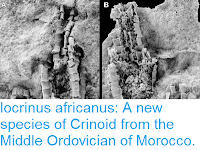Ordinary chondrites, or stony
meteorites, are the most abundant group of meteorites falling on Earth today,
forming about 85% of all such objects. They are divided into three subgroups,
based upon their mineralogy and chemical composition, H (42% of the total), L
(47% of the total) and LL (11% of the total), which are thought to be derived
from three different parent bodies, asteroids broken up by some ancient
collision or other event. The advent of isotopic dating methods has enabled
scientists to calculate the ages of these meteorites, with type H and LL
chondrites all being older than 3.5 billion years (i.e. older than these
methods can effectively date, and probably dating from close to the origin of
the Solar System, but type L chondrites have proved to be much younger, dating
from about 470 million years ago, the Middle Ordovician on Earth. Interestingly
this coincides with a great increase in the number of meteorites and micrometeorites
falling to Earth, as recorded in marine sediments from the time, an increase
which has been linked to the Great Ordovician Biodiversification Event, a
sudden increase in the turnover and evolution of many marine invertebrate
groups, which led to the replacement of many dominant invertebrate groups from
the Cambrian with others more typical of the later Palaeozoic.
In a paper published in the
journal Nature Communications on 14 June 2016, Birger Schmitz of the Astrogeobiology
Laboratory at Lund University and the Hawai’i Institute of Geophysics and Planetology at University of Hawai’i at Manoa, Qing-zhu Yin and Matthew Sanborn
of the Department of Earth and Planetary Sciences at the University of California at Davis, Mario Tassinari, also of the Astrogeobiology Laboratory at
Lund University and Caroline Caplan and Gary Huss, also of the Hawai’i Institute of
Geophysics and Planetology at University of Hawai’i at Manoa, describe a unique meteorite from the Middle Ordovician limestone deposits of
Thorsberg Quarry in southern Sweden.
Micrometeorites, which have
very low masses and are very numerous, are fairly common in the rock record,
but larger meteorites are very rare, and when found are often badly deformed by
their impact and later geological movements, and in addition often have most or
all of their minerals replaced, (as in biological fossils). The limestone
deposits at Thorsberg Quarry are remarkable in that they preserve a large
number of meteors that fell into a shallow sea with a seafloor covered by soft
lime clays, which are preserved without any deformation. As with other ancient
meteorites, most of the original minerals have been replaced, however some
spinels and other minerals have been preserved, allowing some analysis of the
meteors. To date over a hundred meteors from Thorsberg Quarry have been
studied, all of which have been L type ordinary chondrites.
The new meteorite described by
Schmitz et al., Österplana
065, does not
conform mineralogicaly or chemically with an L type chondrite, or any other
previously described meteor type. It appears to lack any of the type of
chromite mineral grains which are common in ordinary chondrites, nor does it
have any aluminium spinels, the most common type in L chondrites, having a
mixture of chromium spinels and chromium-titanium spinels. Furthermore no
silicate minerals could be found within the new meteorite, but large rutile
grains could; this combination of chromium spinels plus rutile is not known
from any of the approximatwly 52 600 meteorites examined and classified by scientists to date.
The Österplana 065 fossil meteorite from the Glaskarten 3 bed. The meteorite is 8 × 6.5 × 2 cm large. It is surrounded by a grey reduction halo, in the otherwise red limestone. Oxygen was consumed when the meteorite weathered on the sea floor. The coin in the image has a diameter of 2.5 cm. Schmitz et al. (2016).
While Österplana
065 is mineralogically different to the type L chondrites it was found alongside, it does share one other feature with them. Cosmic-ray exposure age dating is a method used to date meteorites, by studying nuclides (atoms of a specific isotope of an element) produced by cosmic rays striking minerals on the surface of the rock. Since a rock burried within the centre of an asteroid will not be exposed to cosmic rays, the amount of such nuclides can be used to estimate the time that such a rock has been exposed to space, presumably by the break-up of a larger body. All of the Thorsberg Quarry meteorites, including Österplana
065, yielded cosmic-ray exposure ages of less than a million years, suggesting that they had been released from inside a larger body by a collision less than a million years before falling to Earth and being buried again. Schmitz et al. suggest that this could imply Österplana
065 is a relict of the body which collided the parent body of the L type chondrites, in the collision that resulted in the formation of those bodies, a body of which we have to date discovered no other traces.
See also...
See also...
Follow Sciency Thoughts on Facebook.







